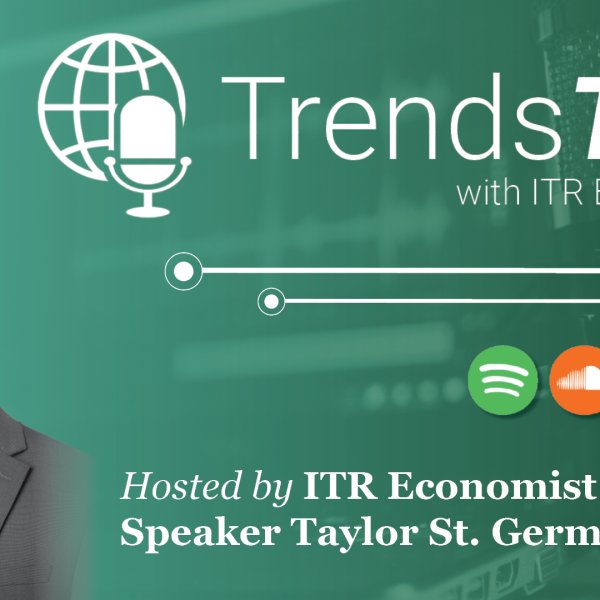- Mon - Fri: 8:30 - 5:00
- +1-603-796-2500
- ITR@itreconomics.com
October 27, 2023
- Home
- portfolio
- TrendsTalk
- October 27, 2023
with Taylor St. Germain
US DEBT IN RELATION TO THE 2030S
Why is the US national debt a main factor in our 2030s Great Depression outlook? Discover four key metrics of US debt and how they relate to our expectations for the next decade in the latest episode of TrendsTalk!
The below transcript is a literal translation of the podcast audio that has been machine generated by Rev.
Hi everyone. My name’s Taylor St. Germain with ITR Economics, and welcome to this episode of Trends Talk.
Today I wanted to talk about debt, particularly the US debt and how it relates to our expectations for the 2030s of an economic downturn that we’re coining a depression beginning in 2030. Now, for those of you that have followed ITR Economics, you’ve heard all about 2030 from us and so this will be an update on the current debt situation. We have a number of drivers behind 2030, demographics, social security, healthcare, inflation, and debt, and I wanted to focus on debt, but we’ll touch on a few others as we have this conversation here today.
Now, I want to first highlight that yes, we have a mild recession in 2024, followed by the second half of this decade really characterized by economic growth. That has not changed and neither has our expectation for what’s coming our way in 2030 at the tail end of this decade. So let’s talk a little bit about debt. There’s really four metrics that I wanted to call out here today. Transfer payments, tax receipts, interest payments on the debt, and consumption expenditures.
Let’s first start off with tax receipts because that’s the positive, right? That’s the income coming into the government. And if we look at current tax receipts today, that’s about 2.9 trillion as of the latest data point that we have. And this data all comes from the BEA or the Bureau of Economic Analysis. So that’s tax receipts, that’s the money coming in. The other three metrics are costs, transfer payments, consumption expenditures, and interest payments.
Now, let’s first start off with transfer payments. Back in March of 2021, that was the peak for transfer payments following the stimulus checks, and at that peak we were just north of 5 trillion in overall transfer payments. Now, that’s an important number because as I just mentioned, current tax receipts are at 2.9 trillion, so transfer payments alone are higher than tax receipts. That means increasing government debt just by looking at transfer payments related to receipts. Now, I mentioned 5 trillion at the height of the transfer payment peak, again, following those stimulus checks. It has retreated to about 4 trillion, but still a number higher than the tax receipt. So again, it’s looking at costs versus how much money we’re bringing in as a government. And just by looking at those metrics alone, it’s clear that our debt situation in terms of increasing debt load is going to worsen as we progress throughout this decade. And that’s what we expect and is a contributing factor to this 2030 depression that we’re expecting.
Now, let’s talk about consumption expenditures. That’s adding another 1.28 trillion as of the latest data point that we have. So if you combine that with transfer payments we’re already at 5.28 trillion in terms of spending. And then I wanted to touch on the last one, which has been a conversation more as of late, and I think it’s because of the slope of the increase in the metric, and that’s interest payments on the debt. So just looking at interest payments on the debt alone, let me give you some reference periods. If we go back to June 2021, the end of the second quarter of 2021, we saw interest payments on the debt come in at approximately $530 billion. Now, over the last few years, we’ve had increased spending, which will drive up that cost, but we’ve also had higher interest rates that we’ve been dealing with as the Federal Reserve raises rates to tackle inflation. So June 2021, that interest payment cost was $530 billion.
Fast-forward two years to the end of the second quarter of this year, June 2023, and that number has now jumped to $842 billion, a pretty significant increase in the slope of that line over the last two years. So you can see how some of these concerns as it relates to spending here in the US, overall levels of debt here in the US, are exacerbated not just by more spending, but by higher interest rates. And again, this is the band warming up for 2030. We don’t expect at this point 2024 to be more than just the mild recession that we’re calling for. And again, we still expect a very attractive period of economic growth as we look at the second half of this decade. But when we think about the demographic trends, particularly the baby boomers moving into the later years of their lives as we approach 2030, that is going to increase these already increasing costs, all major contributors to our 2030 Great Depression expectation.
Now, if you want to hear more about 2030s, our president and CEO, Brian and Alan Beaulieu, they recorded a 2030 webinar during the third quarter, at the end of July. And so please feel free to check that out, still available for all of you that are interested. But again, I just want to reiterate, mild recession in 2024, a very attractive five years of economic growth, but don’t lose sight of that 2030 timeframe because we continue to see the metrics pointing in the direction of a major economic event.
I hope you found this information helpful. My name is Taylor St. Germain on this episode of Trends Talk with ITR Economics, and I’ll see you on the next one.





